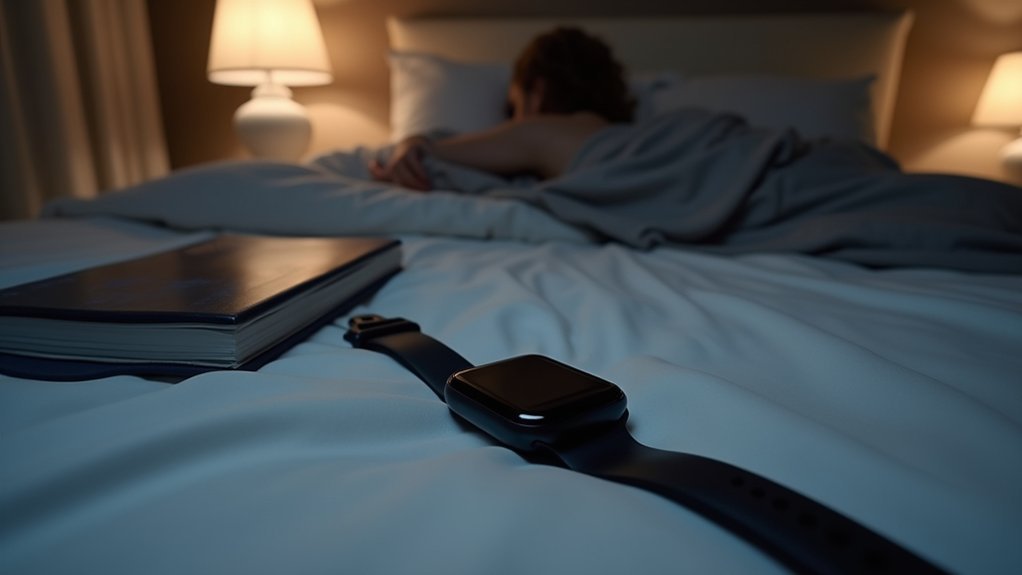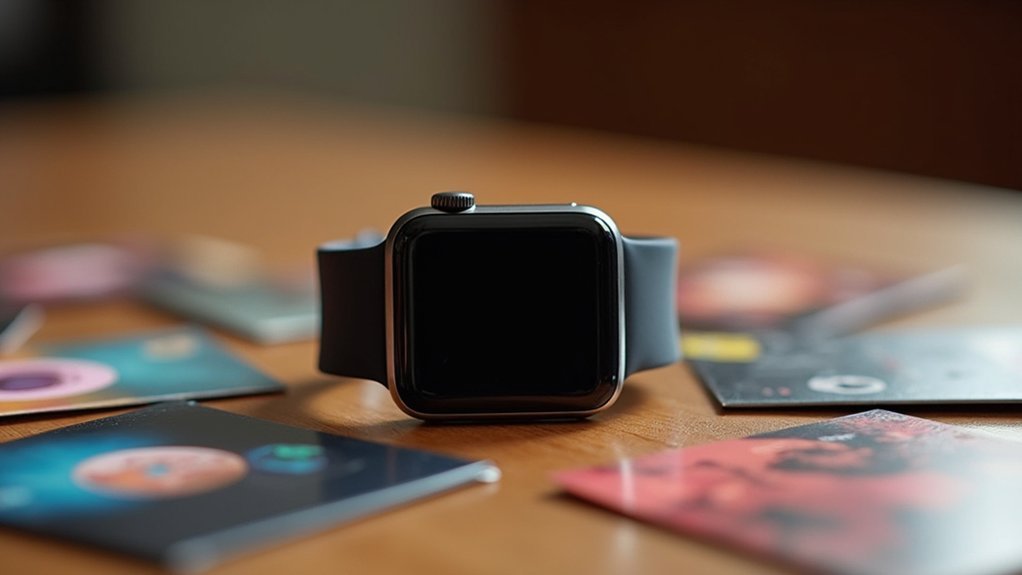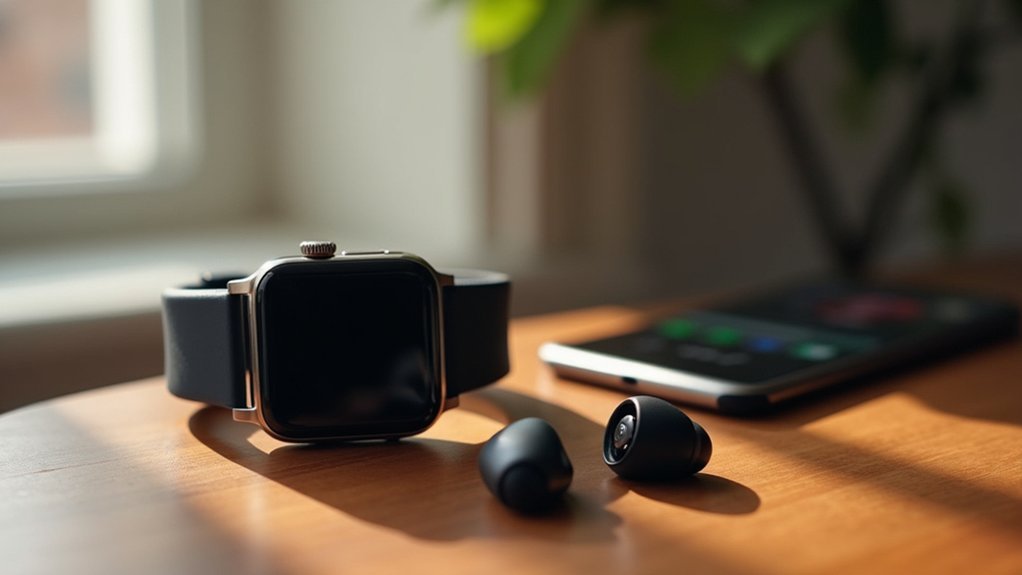To analyze sleep with your fitness watch, focus on weekly trends rather than single nights since these devices achieve only 60% accuracy in sleep stage detection. Track total sleep duration, sleep efficiency, and consistent bedtime patterns while treating detailed stage breakdowns as rough estimates. Look for correlations between lifestyle factors like caffeine intake, screen time, and exercise timing with your sleep quality metrics. Understanding these limitations and applying targeted improvements will help you optimize your sleep habits more effectively.
Understanding Sleep Tracking Technology and Accuracy Limitations
While modern fitness watches promise extensive sleep insights, their tracking relies on indirect measurements that come with inherent limitations you should understand.
Your device primarily uses accelerometers and gyroscopes to detect wrist movements, distinguishing activity from inactivity through actigraphy. Heart rate sensors complement this data by measuring blood volume changes that reflect different sleep stages.
Fitness trackers monitor sleep through wrist movement sensors and heart rate detection, though these indirect measurements have significant accuracy limitations.
However, these methods aren’t foolproof. Your watch can misinterpret quiet wakefulness—like reading in bed—as sleep since you’re not moving. This leads to overestimated sleep duration.
Additionally, heart rate naturally varies with stress, temperature, and caffeine, which can confuse sleep stage detection. The overall estimated accuracy of sleep tracking technology reaches around 60%, significantly limiting the reliability of detailed sleep analysis. Each brand uses proprietary algorithms with limited scientific validation, making accuracy inconsistent across devices and markedly less precise than clinical polysomnography.
Key Sleep Metrics Measured by Fitness Watches
Modern fitness watches capture several core metrics that paint a thorough picture of your nightly rest. These devices track total sleep duration, excluding periods of wakefulness to give you accurate nightly totals and weekly averages.
They’ll also break down your sleep stages, measuring time spent in deep, light, REM, and wake phases using algorithms that estimate shifts. Your watch monitors heart rate and heart rate variability throughout the night, reflecting nervous system regulation and linking directly to sleep quality.
Movement tracking through accelerometers detects restlessness that may indicate poor sleep quality. Some advanced devices now feature Sleep Apnea Detection capabilities that can identify potential breathing disruptions during sleep.
Additional metrics provide extensive nocturnal monitoring:
- Blood oxygen levels (SpO2) for breathing assessment
- Respiration rate and disturbance detection
- Skin temperature changes for overall health insights
Interpreting Sleep Stage Data From Your Wearable Device

Once your fitness watch collects sleep data throughout the night, you’ll need to understand what those colorful sleep stage graphs actually mean.
Your device typically categorizes sleep into four stages: light sleep, deep sleep (slow wave), REM, and awake periods. The data shows minutes or percentages spent in each stage, often displayed as visual cycles across the night.
However, don’t treat these numbers as gospel. Each brand uses different algorithms, so results aren’t comparable between devices. Your watch might confuse quiet wakefulness with actual sleep, especially if you frequently wake up during the night.
Excessive movement can also skew the classifications. Most wearables rely on heart rate and accelerometer data to determine sleep stages, which explains why physical activity during the night can affect accuracy.
Focus on trends rather than single nights, since night-to-night variation is completely normal and expected.
Common Challenges and Factors Affecting Sleep Analysis Accuracy
Despite their convenience and growing sophistication, fitness watches face several inherent limitations that can compromise sleep analysis accuracy. These devices primarily rely on accelerometry and photoplethysmography sensors, which struggle to distinguish between quiet wakefulness and actual sleep states.
Key factors affecting your sleep tracking accuracy include:
- Movement-based detection limitations – Your device may misclassify periods when you’re lying awake quietly as sleep, leading to overestimated total sleep time.
- Environmental factors – External disturbances like noise, light, or temperature changes aren’t captured by wearable sensors, creating gaps in sleep quality assessment.
- Individual physiological differences – Your unique movement patterns and heart rate variations may not align with generalized algorithms designed for broader populations.
Inconsistent device wear and firmware glitches can further distort your sleep metrics. Modern fitness watches have improved their accuracy to 86-89 percent for determining sleep versus awake states, but sleep stage detection remains significantly less reliable at only 50-61 percent accuracy.
Leveraging Sleep Data to Improve Your Sleep Habits

Once you’ve collected several weeks of sleep data from your fitness watch, you can transform those numbers into actionable improvements for your sleep habits.
You’ll start by identifying patterns in your sleep duration, efficiency, and timing to set realistic goals that work with your lifestyle.
From there, you can make targeted changes to your evening routine, sleep environment, or daily habits based on what your data reveals about your specific sleep challenges. Your fitness watch estimates sleep based on measured inactivity rather than direct brain wave monitoring, so focus on consistent trends over time rather than individual night variations.
Identifying Sleep Pattern Trends
Your fitness watch collects sleep data every night, but the real value emerges when you analyze patterns over weeks and months rather than individual nights. Single-night variations don’t tell the complete story – consistent trends reveal actionable insights about your sleep health.
Focus on these key pattern indicators:
- Duration consistency: Track nightly variations and weekend versus weekday differences to identify sleep debt accumulation or social jetlag effects.
- Sleep architecture shifts: Monitor changes in deep, REM, and light sleep percentages that may indicate stress, illness, or lifestyle impacts.
- Long-term stability: Use statistical measures like average duration and variance to assess whether your sleep is becoming more consistent or erratic.
Consumer devices may misidentify periods when you’re lying still as sleep, so be aware that accuracy can decrease during restless nights or periods of wakefulness in bed.
Remember that devices like Fitbit show good accuracy for total sleep time but less precision for sleep stages, so focus primarily on duration trends for the most reliable insights.
Setting Realistic Sleep Goals
After identifying your sleep patterns, you’ll need to translate that data into actionable goals that actually stick. Start by aiming for 7-8 hours nightly, but don’t jump from 5 to 8 hours overnight. Instead, use your fitness watch’s average sleep duration to set incremental targets—go to bed 10-20 minutes earlier each week until you reach your goal.
Focus on consistency over perfection. Lock in fixed bedtimes and wake times, even on weekends, to stabilize your circadian rhythm. Your fitness tracker will show when you’re deviating from this schedule.
Create realistic environmental changes too. Limit screens 60 minutes before bed, avoid late caffeine, and optimize your bedroom’s temperature and darkness. If you can’t fall asleep within 20 minutes, leave your bedroom and do a relaxing activity until you feel tired enough to return.
Track how these adjustments correlate with your sleep quality data to refine what works best.
Making Targeted Lifestyle Changes
While your fitness watch provides the data foundation, transforming those insights into meaningful sleep improvements requires strategic lifestyle adjustments.
When your tracker shows prolonged sleep latency, reduce screen exposure and stimulating activities in the hour before bedtime. If data reveals fragmented sleep or shortened deep sleep phases, adjust your caffeine, alcohol, and heavy meal timing earlier in the day.
Key lifestyle modifications based on your sleep data include:
- Evening routine optimization – Incorporate relaxation techniques or mindfulness exercises when movement and heart rate data indicate frequent restless sleep phases.
- Activity timing adjustments – Schedule physical exercise earlier when tracking shows difficulty falling asleep or poor sleep quality.
- Environmental controls – Modulate artificial light exposure based on sleep onset and wake time inconsistencies from tracker logs.
Best Practices for Reliable Sleep Pattern Analysis

You’ll get the most accurate picture of your sleep when you analyze data across multiple nights rather than fixating on single-night readings.
Individual nights can show significant variability due to stress, environment, or device positioning, so weekly or monthly trends reveal your true sleep patterns.
Focus on the metrics your fitness watch handles best—total sleep time and sleep efficiency—while treating detailed sleep stage breakdowns as rough estimates rather than precise measurements. Keep in mind that trackers may overestimate total sleep time, which is a common limitation across consumer devices.
Track Multiple Night Trends
Single-night sleep data tells only part of your sleep story, but tracking multiple nights reveals the patterns that truly matter for your health.
Your fitness watch collects continuous data that helps identify consistent sleep stages, recurring disturbances, and long-term trends you’d miss otherwise. Remember that sleep tracker data should be viewed as suggestions, and maintaining personal body awareness remains crucial for understanding your actual sleep quality.
Multi-night tracking enables powerful analysis through:
- Sleep Score Analytics – Compare daily scores over weeks to spot improvement trends and identify factors affecting your sleep quality
- Sleep Stage Distribution – Monitor how much time you spend in light, deep, and REM sleep across multiple nights to understand your sleep architecture
- Consistency Patterns – Track bedtime and wake-up regularity to optimize your circadian rhythm and improve overall sleep quality
This thorough approach transforms random sleep data into actionable insights for better rest.
Focus on Reliable Metrics
Although fitness watches can’t match the precision of clinical sleep labs, focusing on their most reliable metrics transforms your sleep data into meaningful insights.
Prioritize sleep onset detection, which achieves 96% accuracy in validated devices like Fitbit and Garmin. Light sleep tracking reaches over 80% reliability, making it trustworthy for analysis. However, treat deep sleep data cautiously since accuracy drops to around 49% in studies.
Use composite scores that combine multiple data points rather than isolated metrics. Garmin’s Sleep Score and Fitbit’s Sleep Stages summaries provide clearer pictures than raw numbers.
Focus on total sleep duration, awakening frequency, and overall sleep quality trends. These consolidated metrics offer actionable feedback for improving your sleep habits while filtering out unreliable single-point measurements. Modern devices also track skin temperature variations, which can indicate sleep disturbances and complement traditional sleep stage monitoring.
When to Seek Professional Medical Evaluation for Sleep Issues
Several warning signs indicate when your fitness watch data should prompt a conversation with a healthcare professional rather than self-management alone.
If you’re experiencing persistent sleep issues despite lifestyle changes, it’s time to seek professional evaluation. Your watch might reveal patterns of frequent awakenings, but it can’t diagnose underlying conditions like sleep apnea or narcolepsy.
Consider professional help when you notice:
- Excessive daytime sleepiness affecting your work performance or daily activities
- Irregular breathing patterns, choking, or gasping during sleep
- Sleep disturbances impacting your mood, cognitive abilities, or overall functioning
High-risk individuals with obesity, hypertension, or cardiovascular conditions should consult sleep specialists for thorough evaluation. Sleep specialists can provide evidence-based practices that follow established clinical guidelines to ensure accurate diagnosis and appropriate treatment recommendations.
Frequently Asked Questions
How Often Should I Charge My Fitness Watch to Avoid Gaps in Sleep Data?
You should charge your fitness watch every 4-7 days based on its battery life. Charge during daytime activities like showering or meals, never overnight, to guarantee continuous sleep tracking without data gaps.
Can I Wear My Fitness Watch Too Tightly or Loosely for Accurate Sleep Tracking?
Yes, you can wear your fitness watch too tightly or too loosely for accurate sleep tracking. You’ll get best results with a snug but comfortable fit that won’t slip during sleep movements.
Do Different Sleep Positions Affect How Well My Fitness Watch Tracks Sleep?
Yes, sleep positions greatly affect your fitness watch’s accuracy. When you sleep with your arm under your head or in positions that obstruct the sensor, heart rate tracking becomes impaired, reducing sleep stage detection reliability.
Should I Manually Start Sleep Mode or Let My Watch Detect Sleep Automatically?
You should let your watch detect sleep automatically for convenience and consistent tracking. Manual mode only helps if you have irregular sleep schedules or take frequent naps that confuse the sensors.
How Do I Export My Sleep Data to Share With My Doctor?
Access your device’s health app or dashboard to export sleep data. Choose CSV or Excel format, select your desired time period, then share the file via email with your doctor for analysis.
In Summary
You’ve learned how fitness watches track sleep and their limitations. Now you’ll understand your sleep stage data better and recognize factors that affect accuracy. Use this knowledge to improve your sleep habits by following best practices for reliable analysis. Remember, while your wearable provides valuable insights, don’t rely on it exclusively. If you’re experiencing persistent sleep issues, you should consult a healthcare professional for proper evaluation and treatment.





Leave a Reply